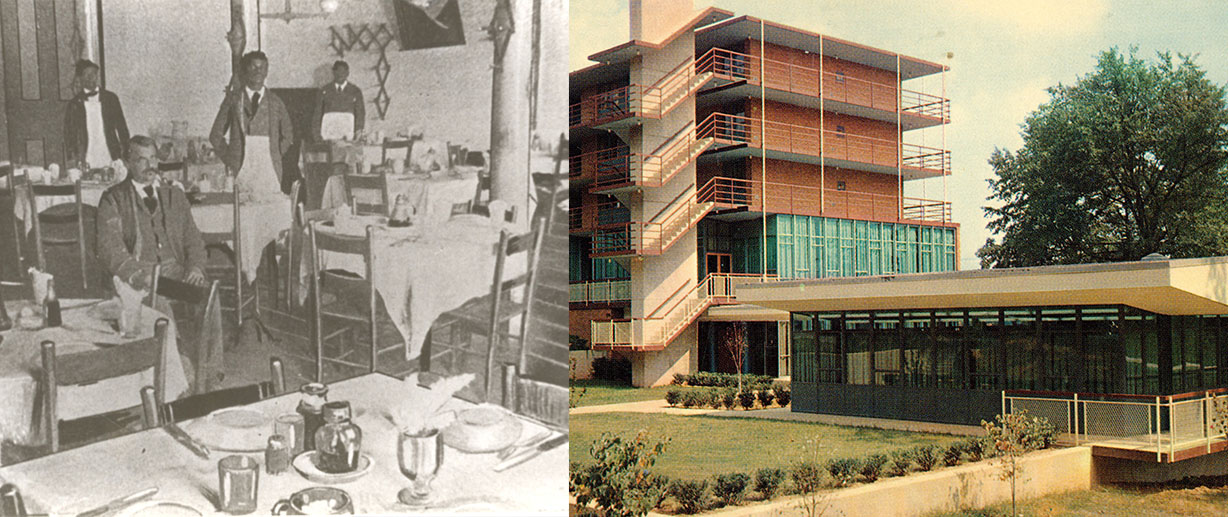Student dining options have evolved quite a bit since Wofford opened in 1854.
At first, the college operated under the “nonresident” system, which meant that Wofford did not provide housing or meals for students. Students often lived with families in Spartanburg. The early catalogues suggested that students could find lodging for around $10 to $12 per month.
Soon, however, students petitioned to live in unused rooms in Main Building. Two brothers, Zach T. and A.S. Whiteside, both members of the class of 1877, started finding ways to prepare their own meals. (The college food court in the Mungo Student Center is named for Zach.) A few years later, a student approached President James H. Carlisle requesting to rent a room in Main Building to start a dining group. The student, T.C. O’Dell of the class of 1886, later recounted that he was short of funds, and without a more economical way of paying for his meals, he might have to leave college. He explained to Carlisle that he believed that a group of students could save funds by hiring a cook and sharing the costs. O’Dell estimated the cost would be about $6 per month for each of them. Carlisle sent them to Professor W.W. Duncan, who supported their plan and gave them a ground floor room in the east wing of Main Building for their dining room as well as a wooden shack for a kitchen rent free. They hired Jim Gillespy, an African American cook from the local community, to prepare their meals. According to a faculty report to the board of trustees in 1882, about 20 students were sharing their meals, and the following year, they had to move to a larger room in Main Building. The students named their dining room “Wightman Hall” in honor of the college’s first president.
The Wofford College Journal of 1891 described the dining hall this way: “The hall is lighted with gas, well heated, and altogether, with its twelve or fourteen tables, presents the appearance of a well-regulated dining room in a modern hotel,” serving food of a high quality. Even in the early 1890s, the monthly bill did not exceed $6.50 a month per student. Wightman Hall was able to serve about 50 students, which was a third of the student body. Carlisle, ever concerned about the moral life of the students, regularly inquired about events in the dining room. The Journal reported that most students participated in daily devotionals after supper and that they took turns leading prayers before meals. Dr. David Duncan Wallace of the class of 1894 remembered the “plain dressing and determined character” of the students who dined there, and he noted that the dining room, later called “College Hall,” continued until about 1908.
Growth in the student body in the early 20th century convinced the trustees to build a large residence hall and to include in it a kitchen and dining room. Alumni immediately set about raising funds, and the college opened James H. Carlisle Memorial Hall in 1912. Most first-year and sophomore students had rooms in the residence hall, and the building’s dining room could accommodate about 225. Dr. Lewis P. Jones ’38 wrote about eating in the dining room in the 1930s, noting that meals included an early breakfast, dinner at 2:30 p.m. after classes had ended, and supper at 6:30 p.m. Either rice or grits appeared at most meals. On Sundays, students had to appear for lunch in a coat and tie, and as meals ended, they were handed a bag containing their supper so that the cooks could have an evening off. The dining room had no buffet line, with meals being served at the tables. While most students ate in Carlisle Hall, during the years that Snyder Residence Hall operated, its residents ate in their own dining room.

The college followed the model of building a residence hall with a dining room when it designed Wightman Hall. Opened in the summer of 1958, Wightman’s dining room, located on the second floor, featured dual serving lines as well as seating for about 400 students. Plans included a new kitchen, located on the ground floor, with food being moved upstairs using dumbwaiters. Compared to Carlisle Hall, Wightman’s dining room was more spacious, modern and efficient in terms of being able to handle a larger student body.
Arguably the most famous incident in the brief history of the Wightman dining room was the infamous 1965 food fight, which has grown to mythic proportions with every retelling. However, continued growth in the student body in the 1960s made Wightman Hall inadequate within less than a decade. The board of trustees began considering a new dining facility as early as 1965. Plans began to take shape for a campus center, with a dining room to seat more than 500 students, gathering spaces, offices and meeting rooms. Because the kitchen under Wightman Hall was so new, the college chose to connect the two buildings via a service corridor rather than build a new facility. That meant, however, the inconvenience of moving food between buildings and upstairs to supply the three serving lines.

The Burwell Campus Center opened in the fall of 1969 with a major gift from Ernest and Ethel Burwell supporting much of the cost. Ernest Burwell had been a Spartanburg business leader since 1920 and was president of Burwell Chevrolet. Since it opened, the Burwell Dining Room and the other dining areas in the building have witnessed constant change, including admission of women as resident students, continued growth in the student body and changing student tastes and dietary requirements. With its most recent renovation in 2020-21, the Burwell Building is poised to serve several more generations of Wofford students, offering a place to gather, share meals and build community.
By Dr. Phillip Stone ’94, archivist
